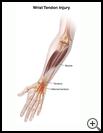
Wrist Tendon Injury
________________________________________________________________________
KEY POINTS
- A wrist tendon injury is stretching or tearing of one or more of the strong bands of tissue that attach the muscles to bones in your wrist.
- Change or stop doing the activities that cause pain until the injury heals.
- A wrist tendon injury can be treated with splints, exercise, ice, and sometimes with medicine or surgery.
________________________________________________________________________
What is a wrist tendon injury?
A wrist tendon injury is a problem with the muscles and tendons in your wrist. Tendons are bands of strong tissue that attach muscle to bone. You use the tendons and muscles in your wrist to move your wrist in all directions.
Tendons can be injured suddenly or they may be slowly damaged over time. You can have tiny or partial tears in your tendon. If you have a complete tear of your tendon, it is called a rupture. Other tendon injuries may be called a strain, tendinosis, or tendinitis.
What is the cause?
Wrist tendon injuries can be caused by:
- Overuse of the tendon from a sport or work activity that involves moving your wrist, such as throwing, catching, bowling, hitting a tennis ball, typing, or sewing
- A sudden activity that twists or tears your tendon, such as falling and landing on your wrist
What are the symptoms?
Symptoms may include:
- Pain in your wrist and forearm with repeated activity
- Tenderness when the area is touched
- Swelling around your wrist
How is it diagnosed?
Your healthcare provider will ask about your symptoms, activities, and medical history and examine you. Tests may include:
- X-rays
- MRI, which uses a strong magnetic field and radio waves to show detailed pictures of your wrist
How is it treated?
You will need to change or stop doing the activities that cause pain until the tendon has healed. For example, you may need to run instead of play racquet sports. A splint or tape that keeps your wrist or thumb from moving may help. Ask your provider about this.
Your healthcare provider may recommend stretching and strengthening exercises to help you heal.
If you keep having pain, your provider may give you a shot of a steroid medicine. If these treatments don't work, you may need surgery to relieve the pain.
The pain often gets better within a few weeks with self-care, but some injuries may take several months or longer to heal. It’s important to follow all of your healthcare provider’s instructions.
How can I take care of myself?
To keep swelling down and help relieve pain:
- Put an ice pack, gel pack, or package of frozen vegetables wrapped in a cloth on the area every 3 to 4 hours for up to 20 minutes at a time.
- Do ice massage. To do this, first freeze water in a Styrofoam cup, then peel the top of the cup away to expose the ice. Hold the bottom of the cup and rub the ice over the painful area for 5 to 10 minutes. Do this several times a day while you have pain.
- Keep your wrist up on a pillow when you sit or lie down.
- Take nonprescription pain medicine, such as acetaminophen, ibuprofen, or naproxen. Read the label and take as directed. Unless recommended by your healthcare provider, you should not take these medicines for more than 10 days.
- Nonsteroidal anti-inflammatory medicines (NSAIDs), such as ibuprofen, naproxen, and aspirin, may cause stomach bleeding and other problems. These risks increase with age.
- Acetaminophen may cause liver damage or other problems. Unless recommended by your provider, don't take more than 3000 milligrams (mg) in 24 hours. To make sure you don’t take too much, check other medicines you take to see if they also contain acetaminophen. Ask your provider if you need to avoid drinking alcohol while taking this medicine.
- Put moist heat on the sore area for 10 to 15 minutes before you do warm-up and stretching exercises. Moist heat may help relax your muscles. Moist heat includes heat patches or moist heating pads that you can buy at most drugstores, a warm wet washcloth, or a hot shower. To prevent burns to your skin, follow directions on the package and do not lie on any type of hot pad. Don’t use heat if you have swelling.
Follow your healthcare provider's instructions, including any exercises recommended by your provider. Ask your provider:
- How and when you will get your test results
- How long it will take to recover
- If there are activities you should avoid, including how much you can lift, and when you can return to your normal activities
- How to take care of yourself at home
- What symptoms or problems you should watch for and what to do if you have them
Make sure you know when you should come back for a checkup. Keep all appointments for provider visits or tests.
How can I help prevent wrist tendon injuries?
Warm-up exercises and stretching before activities can help prevent injuries. If your arm or wrist hurts after exercise, putting ice on it may help keep it from getting injured.
Follow safety rules and use any protective equipment recommended for your work or sport.
Avoid activities that cause pain--for example, throwing, hitting a tennis ball, and typing.

